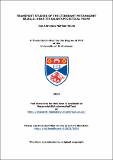Files in this item
Transport studies of the itinerant metamagnet Sr₃Ru₂O₇ near its quantum critical point
Item metadata
| dc.contributor.advisor | Mackenzie, Andrew | |
| dc.contributor.author | Bruin, Jan Adrianus Nathan | |
| dc.coverage.spatial | xiii, 152 | en_US |
| dc.date.accessioned | 2013-06-10T14:25:45Z | |
| dc.date.available | 2013-06-10T14:25:45Z | |
| dc.date.issued | 2012 | |
| dc.identifier.uri | https://hdl.handle.net/10023/3656 | |
| dc.description.abstract | Strongly correlated metals are known to give rise to a variety of exotic states. In particular, if a system is tuned towards a quantum critical point, new ordered phases may arise. Sr₃Ru₂O₇ is a quasi-two dimensional metal in which field-tuned quantum criticality has been observed. In very pure single crystals of this material, a phase with unusual transport properties forms in the vicinity of its quantum critical point. Upon the application of a small in-plane field, electrical resistivity becomes anisotropic, a phenomenon which has led to the naming of this phase as an `electron nematic'. The subject of this thesis is a study of the electrical transport in high purity crystals of Sr₃Ru₂O₇. We modified an adiabatic demagnetisation refrigerator to create the conditions by which the entire temperature-field phase diagram can be explored. In particular, this allowed us to access the crossover between the low-temperature Fermi liquid and the quantum critical region. We also installed a triple axis `vector magnet' with which the applied magnetic field vector can be continuously rotated within the anisotropic phase. We conclude that the low- and high-field Fermi liquid properties have a complex dependence on magnetic field and temperature, but that a simple multiple band model can account for some of these effects, and reconcile the measured specific heat, dHvA quasiparticle masses and transport co-efficients. At high temperatures, we observe similarities between the apparent resistive scattering rate at critical tuning and those observed in other quantum critical systems and in elemental metals. Finally, the anisotropic phase measurements confirm previous reports and demonstrate behaviour consistent with an Ising-nematic, with the anisotropy aligned along either of the principal crystal axes. Our observations are consistent with the presence of a large number of domains within the anisotropic phase, and conclude that scattering from domain walls is likely to contribute strongly to the large measured anisotropy. | en_US |
| dc.language.iso | en | en_US |
| dc.publisher | University of St Andrews | |
| dc.subject.lcc | QC611.98R8B8 | |
| dc.subject.lcsh | Ruthenium oxide superconductors--Electric properties | en_US |
| dc.subject.lcsh | Magnets--Electric properties | en_US |
| dc.subject.lcsh | Electron transport | en_US |
| dc.subject.lcsh | Magnetism, Band theory of | en_US |
| dc.subject.lcsh | Quantum theory | en_US |
| dc.title | Transport studies of the itinerant metamagnet Sr₃Ru₂O₇ near its quantum critical point | en_US |
| dc.type | Thesis | en_US |
| dc.contributor.sponsor | Engineering and Physical Sciences Research Council (EPSRC) | en_US |
| dc.type.qualificationlevel | Doctoral | en_US |
| dc.publisher.institution | The University of St Andrews | en_US |
This item appears in the following Collection(s)
Items in the St Andrews Research Repository are protected by copyright, with all rights reserved, unless otherwise indicated.

